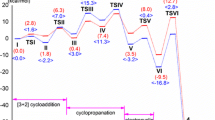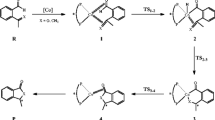Abstract
Density functional theory (DFT) was used to investigate the Rh(I)-catalyzed intermolecular hydroacylation of vinylsilane with benzaldehyde. All intermediates and transition states were optimized completely at the B3LYP/6-31G(d,p) level (LANL2DZ(f) for Rh). Calculations indicated that Rh(I)-catalyzed intermolecular hydroacylation is exergonic, and the total free energy released is −110 kJ mol−1. Rh(I)-catalyzed intermolecular hydroacylation mainly involves the active catalyst CA2, rhodium–alkene–benzaldehyde complex M1, rhodium–alkene–hydrogen–acyl complex M2, rhodium–alkyl–acyl complex M3, rhodium–alkyl–carbonyl–phenyl complex M4, rhodium–acyl–phenyl complex M5, and rhodium–ketone complex M6. The reaction pathway CA2 + R2 → M1b → T1b → M2b → T2b1 → M3b1 → T4b → M4b → T5b → M5b → T6b → M6b → P2 is the most favorable among all reaction channels of Rh(I)-catalyzed intermolecular hydroacylation. The reductive elimination reaction is the rate-determining step for this pathway, and the dominant product predicted theoretically is the linear ketone, which is consistent with Brookhart’s experiments. Solvation has a significant effect, and it greatly decreases the free energies of all species. The use of the ligand Cp′ (Cp′ = C5Me4CF3) decreased the free energies in general, and in this case the rate-determining step was again the reductive elimination reaction.

Rh(I)-catalyzed intermolecular hydroacylation was investigated using density functional theory (DFT). This study suggests that the hydroacylation is exergonic, and that the dominant product is the linear ketone












Similar content being viewed by others
References
Jun CH, Lee JH (2004) Pure Appl Chem 76:577–587
Jia C, Kitamura T, Fujiwara Y (2001) Acc Chem Res 34:633–639
Kakiuchi F, Murai S (1999) Top Organomet Chem 3:47–79
Guari Y, Sabo-Etienne S, Chaudret B (1999) Eur J Inorg Chem 1047–1055
Arndtsen BA, Bergman RG, Mobley A, Peterson TH (1995) Acc Chem Res 28:154–162
Shilov AE, Shul’pin GB (1997) Chem Rev 97:2879–2932
Dyker G (1999) Angew Chem Int Ed 38:1698–1712
Ritleng V, Sirlin C, Pfeffer M (2002) Chem Rev 102:1731–1770
Labinger JA, Bercaw JE (2002) Nature 417:507–514
Kakiuchi F, Murai S (2002) Acc Chem Res 35:826–834
Inoue SI, Takaya H, Tani K, Otsuka S, Sato T, Noyori R (1990) J Am Chem Soc 112:4897–4905
Bergens SH, Bosnich B (1991) J Am Chem Soc 113:958–967
Barnhart RW, Wang XQ, Noheda P, Bergens SH, Whelan J, Bosnich B (1994) J Am Chem Soc 116:1821–1830
Jun CH, Hong JB, Lee DY (1999) Synlett 1–12
Aloise AD, Layton ME, Shair MD (2000) J Am Chem Soc 122:12610–12611
Jun CH, Chung JH, Lee DY, Loupy A, Chatti S (2001) Tetrahedron Lett 42:4803–4805
Tanaka K, Fu GC (2001) J Am Chem Soc 123:11492–11493
Willis MC, Sapmaz S (2001) Chem Commun 2558–2559
Jun CH, Moon CW, Lee DY (2002) Chem Eur J 8:2422–2428
Tanaka K, Fu GC (2003) J Am Chem Soc 125:8078–8079
Takeishi K, Sugishima K, Sasaki K, Tanaka K (2004) Chem Eur J 10:5681–5688
Jun CH, Jo EA, Park JW (2007) Eur J Org Chem 1869–1881
Roy AH, Lenges CP, Brookhart M (2007) J Am Chem Soc 129:2082–2093
Moxham GL, Randell-Sly H, Brayshaw SK, Weller AS, Willis MC (2008) Chem Eur J 14:8383–8397
Hyatt IFD, Anderson HK, Morehead AT, Sargent AL (2008) Organometallics 27:135–147
Chung LW, Wiest O, Wu YD (2008) J Org Chem 73:2649–2655
Frisch MJ, Trucks GW, Schlegel HB, Scuseria GE, Robb MA, Cheeseman JR, Montgomery JA, Vreven JT, Kudin KN, Burant JC, Millam JM, Iyengar SS, Tomasi J, Barone V, Mennucci B, Cossi M, Scalmani G, Rega N, Petersson GA, Nakatsuji H, Hada M, Ehara M, Toyota K, Fukuda R, Hasegawa J, Ishida M, Nakajima T, Honda Y, Kitao O, Nakai H, Klene M, Li X, Knox JE, Hratchian HP, Cross JB, Adamo C, Jaramillo J, Gomperts R, Stratmann RE, Yazyev O, Austin AJ, Cammi R, Pomelli C, Ochterski JW, Ayala PW, Morokuma K, Voth GA, Salvador P, Dannenberg JJ, Zakrzewski VG, Dapprich S, Daniels AD, Strain MC, Farkas O, Malick DK, Rabuck AD, Raghavachari K, Foresman JB, Ortiz JV, Cui Q, Baboul AG, Clifford S, Cioslowski J, Stefanov BB, Liu G, Liashenko A, Piskorz P, Komaromi I, Martin RL, Fox DJ, Keith T, Al-Laham MA, Peng CY, Nanayakkara A, Challacombe M, Gill PMW, Johnson B, Chen W, Wong MW, Gonzalez C, Pople JA (2003) Gaussian 03, revision B.03. Gaussian, Inc., Pittsburgh
Parr RG, Yang W (1989) Density-functional theory of atoms and molecules. Oxford University Press, New York
Pisano L, Farriol M, Asensio X, Gallardo I, González-Lefont A, Lluch JM, Marquet J (2002) J Am Chem Soc 124:4708–4715
Pierini AB, Vera DMA (2003) J Org Chem 68:9191–9199
Pratt DA, Heer ML, Mulder P, Ingold KU (2001) J Am Chem Soc 123:5518–5526
Becke AD (1993) J Chem Phys 98:5648–5652
Lee C, Yang W, Parr RG (1988) Phys Rev B 37:785–789
Ehlers AW, Böhme M, Dapprich S, Gobbi A, Höllwarth A, Jonas V, Köhler KF, Stegmann R, Veldkamp A, Frenking G (1993) Chem Phys Lett 208:111–114
Gonzalez C, Schlegel HB (1990) J Phys Chem 94:5523–5527
Flükiger P, Lüthi HP, Portmann S, Weber J (2000–2002) MOLEKEL 4.3. Swiss Center for Scientific Computing, Manno
Portmann S, Lüthi HP (2000) Chimia 54:766–770
Miertus S, Tomasi J (1982) Chem Phys 65:239–245
Bader RFW (1990) Atoms in molecules—a quantum theory (Int Ser Monogr Chem vol 22). Oxford University Press, Oxford
Bader RFW, Popelier PLA, Keith TA (1994) Angew Chem Int Ed Engl 33:620–631
Carpenter JE, Weinhold F (1988) J Mol Struct (THEOCHEM) 169:41–50
Foster JP, Weinhold F (1980) J Am Chem Soc 102:7211–7218
Reed AE, Weinstock RB, Weinhold F (1985) J Chem Phys 83:735–746
Reed AE, Curtiss LA, Weinhold F (1988) Chem Rev 88:899–926
Biegler-König F, Schönbohm J, Derdau R, Bayles D, Bader RFW (2002) AIM 2000, version 2.0. McMaster University, Hamilton
Glendening ED, Badenhoop JK, Reed AE, Carpenter JE, Bohmann JA, Morales CM, Weinhold F (2001) NBO 5.0. Theoretical Chemistry Institute, University of Wisconsin, Madison
Gorelsky SI, Lever ABP (2001) J Organomet Chem 635:187–196
Gorelsky SI (1997) AOMix: program for molecular orbital analysis. York University, Toronto. http://www.sg-chem.net/
Gorelsky SI, Ghosh S, Solomon EI (2006) J Am Chem Soc 128:278–290
Gao JG, Wang F, Meng QX, Li M (2009) Mol Simulat 35:419–427
Wang F, Meng QX, Li M (2010) Int J Quantum Chem 110:850–859
Acknowledgments
This work was supported by the Key Project of Science and Technology of the Ministry of Education, P.R. (grant no. 104263), Natural Science Foundation of Chongqing City, P.R. (grant no. CSTC-2004BA4024).
Author information
Authors and Affiliations
Corresponding author
Electronic supplementary material
Computational details about the energies and detailed structures of the stationary points in the reactions are given in the electronic supplementary material.
ESM 1
(DOC 1936 kb)
Rights and permissions
About this article
Cite this article
Meng, Q., Shen, W. & Li, M. Mechanism of intermolecular hydroacylation of vinylsilanes catalyzed by a rhodium(I) olefin complex: a DFT study. J Mol Model 18, 1229–1239 (2012). https://doi.org/10.1007/s00894-011-1151-z
Received:
Accepted:
Published:
Issue Date:
DOI: https://doi.org/10.1007/s00894-011-1151-z




